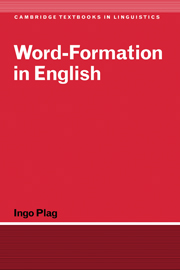Book contents
- Frontmatter
- Contents
- Preface
- Abbreviations and notational conventions
- Introduction
- 1 Basic concepts
- 2 Studying complex words
- 3 Productivity and the mental lexicon
- 4 Affixation
- 5 Derivation without affixation
- 6 Compounding
- 7 Theoretical issues: modeling word-formation
- Answer key to exercises
- References
- Subject index
- Affix index
- Author index
6 - Compounding
- Frontmatter
- Contents
- Preface
- Abbreviations and notational conventions
- Introduction
- 1 Basic concepts
- 2 Studying complex words
- 3 Productivity and the mental lexicon
- 4 Affixation
- 5 Derivation without affixation
- 6 Compounding
- 7 Theoretical issues: modeling word-formation
- Answer key to exercises
- References
- Subject index
- Affix index
- Author index
Summary
Outline
This chapter is concerned with compounds. Section 6.1 focuses on the basic characteristics of compounds, investigating the kinds of element compounds are made of, their internal structure, headedness, and stress patterns. This is followed by descriptions of individual compounding patterns and the discussion of the specific empirical and theoretical problems these patterns pose. In particular, nominal, adjectival, verbal, and neoclassical compounds are examined, followed by an exploration of the syntax–morphology boundary.
Recognizing compounds
Compounding was mentioned in passing in the preceding chapters and some of its characteristics have already been discussed. For example, in chapter 1 we briefly commented on the orthography and stress pattern of compounds, and in chapter 4 we investigated the boundary between affixation and compounding and introduced the notion of neoclassical compounds. In this chapter we will take a closer look at compounding and the intricate problems involved in this phenomenon. Although compounding is the most productive type of word-formation process in English, it is perhaps also the most controversial one in terms of its linguistic analysis and I must forewarn readers seeking clear answers to their questions that compounding is a field of study where intricate problems abound, numerous issues remain unresolved, and convincing solutions are generally not so easy to find.
Let us start with the problem of definition: what exactly do we mean when we say that a given form is a compound?
- Type
- Chapter
- Information
- Word-Formation in English , pp. 132 - 164Publisher: Cambridge University PressPrint publication year: 2003



